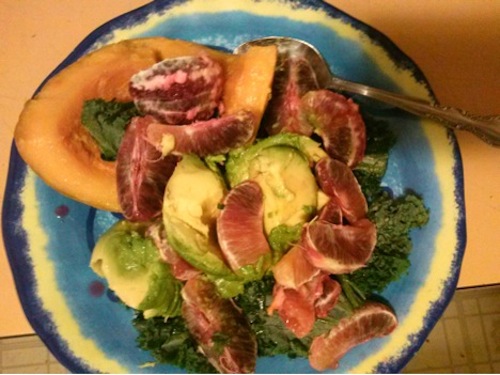Sustainability comes from the Latin verb, sustenere which means to under hold, or to keep in existence; maintain or prolong.
Sustainable cooking is preparing food while being mindful of one’s health and pocketbook as well as considering the environmental impact and effort put into the ingredients.
Through being efficient with resources such as the labor, water, compost and fossil fuels, we can try to eliminate waste, unlock the nourishment potential in the ingredients and reduce harm to ourselves, others and the environment.
Cooking sustainably helps to prolong the overall health (physical, mental, emotional, spiritual and financial) of ourselves, our communities and the Earth.
When I eat in a sustainable manner, I feel in harmony with myself, others and the environment. I feel that I am not only taking care of myself but also other living beings, and this beautiful and mysterious home we all share, planet Earth.
Below is an example of sustainable cooking. This dish is full of essential vitamins, minerals and antioxidants.
Welcome, Spring!
Kabocha Squash Salad
Makes 4 servings at 82 cents per serving
One Kabocha squash: 50 cents at my local produce market.
One bunch of kale: 79 cents at my local produce market.
One 3 lb. bag of blood oranges: $1.99 at my local produce market.
One avocado: 0 cents from my parents’ tree.
Total cost= $3.28
Plus extra blood oranges, pepitas or Kabocha squash seeds and kale to snack on and/or eat later.
In a medium pot, add about two inches of water and let it boil.
Quarter the Kabocha squash.
Remove the seeds and set aside to roast later.
When the water boils, place the squash quarters in the water, lower heat and cover with a lid to keep the steam in the pot and cook the squash.
Simmer for about 20-30 minutes (until you can pierce the flesh with a fork and it goes all the way through).
Be careful not to overcook it or the squash will fall apart and turn mushy. If you undercook it, it will be hard to chew.
(It’s like pasta; you want to cook it to the texture you desire.)
Wash kale, chop it, set aside what you will use and put the rest into a reusable container and freeze to use later.
Cut the avocado in half and scoop out the insides with a spoon.
Unpeel the blood oranges and arrange on the plate.
To roast Kabocha squash seeds:
Preheat oven to 350 degrees.
Keep the membranes on (it is a lot of work to remove them), and you don’t have to wash the seeds.
With about a cup of seeds, place in a small bowl and season them. I seasoned it with olive oil, black Hawaiian sea salt, and Mysore Masala, an Indian blend of spices.
Combine all ingredients.
Spread the seeds out on a baking sheet and roast them for about 30 minutes. With a spoon, check on them after about 20 minutes, and turn and move the seeds around so they will roast evenly.
The membranes will dehydrate and fall off themselves and the seeds will separate. The seeds will look plump and toasted when they’re ready.
When they’re done, let them cool for about 15 minutes.
These make a great snack or garnish for salads and main dishes.
The end product looks happy with the bright green from kale, yellow/orange from squash, red from the blood orange and milky green from avocado. The flavors are complemented well, too. There is a good mixture of sweet (squash and orange), bitter (kale), and fats (avocado).
You can season it with olive oil, or the pepitas, too.
Buen provecho!
The ingredients for this recipe did not cost a whole pay check to buy and the recipe provides a nutritious meal.
I buy my produce from a small business where they get regular shipments from mostly Central California. You may already have some ingredients in your pantry that you can use, which means you won’t have to buy it again, or you can substitute.
The money you save on your food costs will add up and you can reward yourself with something you have been putting off. And the carbon footprint will be lighter on our Mother Earth.
With sustainable cooking, everyone wins; it’s not a zero-sum equation for happiness, where the balance has to be zero. My happiness +1 plus your suffering -1 = 0. It’s more complicated than that.
May we all see the gift we were given to be on this planet Earth!
*Side note:
California has been experiencing a bad, prolonged drought so I am more conscious of how much water I am using. If it’s not necessary, I use less. I recently drove along the Interstate 5 highway through Central California crossing through the fruit/vegetable heartland that supplies produce to the entire country and other countries as well. Whole orchards are uprooted because of the shortage of water. The trees looked like corpses toppled over. There were many signs noting that “No Water = No Jobs,” and “Congress Created this Dust Bowl.” The farmers cannot afford the water for some thirsty plants such as tomatoes, and are switching to less water consuming plants such as pistachios and almonds. In Porterville, California, the eastern most part of the Central Valley, there is such a water shortage that their water taps are empty. People cannot wash and cook fresh vegetables and fruit, and, instead eat canned food.
Sources:
Relephant:
Is the Local Food Movement Really Sustainable?
Author: Stephanie Lee
Apprentice Editor: Brandie Smith/Editor: Catherine Monkman
Photos: Courtesy of the Author
Facebook is in talks with major corporate media about pulling their content into FB, leaving other sites to wither or pay up if we want to connect with you, our readers. Want to stay connected before the curtain drops? Sign up for our curated, quality newsletters below.








Read 0 comments and reply